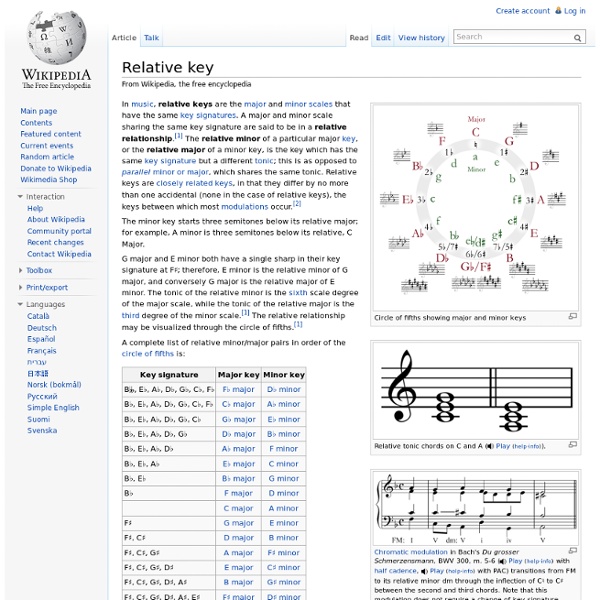Relative key
Circle of fifths showing major and minor keys Relative tonic chords on C and A ( Play ). Chromatic modulation in Bach's Du grosser Schmerzensmann, BWV 300, m. 5-6 ( Play with half cadence, Play with PAC) transitions from FM to its relative minor dm through the inflection of C♮ to C♯ between the second and third chords. The minor key starts three semitones below its relative major; for example, A minor is three semitones below its relative, C Major. G major and E minor both have a single sharp in their key signature at F♯; therefore, E minor is the relative minor of G major, and conversely G major is the relative major of E minor. A complete list of relative minor/major pairs in order of the circle of fifths is: See also[edit] References[edit]
The major scale modes
When you first set out to learn your scales, it can be discouraging. There are so many of them, and their names are so bewildering. The good news is that when you learn one scale, you get a bunch of other scales “for free.” To understand modes, picture a set of Scrabble tiles. Now imagine your Scrabble tiles spell ABCDEFG. This post will walk you through all of the modes of C major. Each mode goes with a chord, so I’ve listed those too, along with real-world examples. C to C – Ionian mode Ionian mode is just the regular old major scale. Scale: C D E F G A B Chord: C E G B D F A -- Cmaj7 Examples include everything from “Jingle Bells” to the William Tell Overture. D to D – Dorian mode Same as the D natural minor scale, but with a natural sixth. Scale: D E F G A B C Chord: D F A C E G B -- Dm7 “So What” by Miles Davis uses Dorian all the way through, in D on the main part and in Eb on the bridge. The ninth, eleventh and thirteenth in D dorian are E, G and B. E to E – Phrygian mode
Echoes - Insight for Independent Artists
Basic Music Theory for Beginners | TrueGuitarist.com Free Video Guitar Lessons
What follows is just a brief summary of basic theory and harmony necessary to understand practical applications on your instrument. The natural sounds are: You might also find in some books the name of these notes in Italian (nothing to do with ‘solfege’!) Do,Re,Mi,Fa,Sol,La,Si and in German C,D,E,F,G,A,H. # = sharp: raises the given note of a half step. ## = double sharp: raises the given note of two half steps (also noted ‘x’). b = flat: lowers the given note of a half step. bb = double flat: lowers the given note of two half steps. = natural: cancels sharps and flats (double natural cancels double sharps and flats). The chromatic scale contains all 12 natural and altered sound (using sharps and flats). Notes called with a different name, but identifying the same sound, are called enharmonic (i.e.: C# e Db). An interval is the distance between two notes. Intervals of a second, third, sixths and seventh are called major. Intervals of a fourth, fifth and octave are called perfect.
Become better at Sight Reading with Practice Sight Reading.com
Related:
Related:



